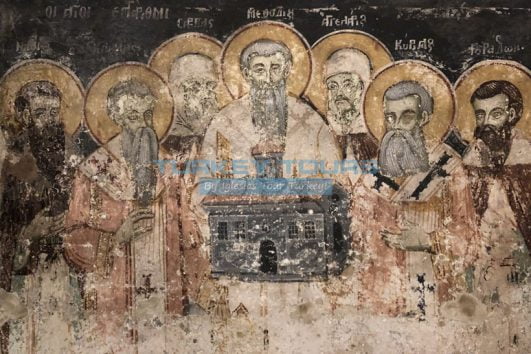FOOTSTEPS OF ALEXANDER THE GREAT!
Alexander the Great certainly wanted to conquer the Persian Empire after ascending the throne. In the spring of 334 BC, he sets out with his army from the city of Amphipolis in Central Macedonia. In May of the same year, the first major battle of Alexander the Great’s Asian expedition, which crossed the Dardanelles Strait, took place on the banks of the Granikos River in the north-east of Troas.
Proceeding along the Gallipoli Peninsula, Alexander the Great visits the grave of “Protasilaos”, one of the Iliad heroes, and sets a great fire here. Then he crosses from Dardanelles Strait to Troy to show his respect to Achilles, the great warrior of the Iliad. According to Greek and Roman period writers, the tomb of Achilles was located in Sivritepe Tumulus.
This visit was of great importance to Alexander; because he believed that his ancestry came from Andromache, wife of Hector of Troy, and Achilles from Akha, the enemy of Hector during the Trojan War. Besike Cape, located on the seashore, is also known as “Achilleion” in sources.
ROAD THROUGH PERKOTE
Alexander then meets with his army in Abydos and marches towards the city of Perkote. Perkote is an Anatolian city mentioned in the Iliad, and means “High Fortress” in Luwi-Pelasg language. The Mekodon army, which has set up camp in the Arisbe plain called Zelia, moves eastward and reaches Lampsakos (Lapseki). His next destination is the city of ‘Daskyleion’, which is the center of Persian Satrap. Lapseki settlement is an ancient Anatolian city known as “Pityausa” before the Hellenic migrations, and the name Lampsakos comes from Lampseke, the daughter of King Mandrom. It is known that there is a picture of a winged horse (Pegasus) on the coins minted in this city.
MACEDONIAN ARMY AND PERSIAN ARMY FIGTS
The Macedonian army “Granikos” confronts the Persian army for the first time around the Biga River. War was quite tough. There were also Greek mercenaries in the Persian army. As the commander of the mercenaries in the Persian army, Memnon knew very well the power of the Macedonian phalanxes; he suggested drawing the Persian army into the country instead of fighting them face to face. As they retreated they would destroy all crops and food. Thus, the Macedonian army following them would be weakened by hunger and their supply routes would have been cut.
Memnon’s proposal was not accepted by the Persians, and the attack was immediately launched in line with the decision of the Persian war council. The strategic importance of this region, located between the Ancient Troas and the border of Mysia, was great. Because of its strategic importance, it has been described as “The Gates of Asia“.
In addition, the roads connecting Daskyleion, the capital of Hellespontos Phygia satrapy, to Kyzikos and Lampsakos passed here. Although the election of Granikos seems to give the Persians an advantage as they compelled Alexander to fight in a battlefield they determined, the war did not end as they had hoped.
The Persian army relied on their cavalry. The most reliable source on this subject is the information provided by Diodoros and Arrianos. The Persian cavalry, consisting of approximately twenty thousand soldiers, was lined up on the slopes east of the Granikos plain, about 2.5 km long, with sixteen rows of cavalry.
On the left-wing, Greek mercenaries of unknown number and soldiers from their own lands took a position, while the Cilician satrap Arsames, then Hellespontos Phrygian satrap Artistes with Paphlogonians and Lydia and Ionian satrap Spithridates with the Hyrkanian cavalry. It is not certain who the main great power in the center was, but probably the Capadokians under the command of the satrap Mithrovouzanes. The right-wing was held by two thousand Bactrian cavalries, the other two thousand under the command of the Reominthas and a thousand Medis.
Less than twenty thousand Persian infantry were placed behind the cavalry line. In this case, the number of Greek mercenaries in the Persian army should not exceed five thousand. Alexander the Great drove five thousand hundred cavalries and thirteen thousand infantry on the battlefield. While he himself took command of the right-wing, he placed the famous Pharmenion on the left-wing. Although Alexander’s life was in danger during the collision, Kleitos was rescued.
MACEDONIAN ARMY BEATS PERSIAN ARMY
In addition to many factors, his strategy ability played a major role in Alexander’s victory in the first major battle in Asian territory. The professional soldiers called the ‘Phalanx’, who formed the center of the Macedonian army, played a major role in the victory. This military unit, known for its six-meter long spears, overcame the Persians, who were superior in number. The famous commander Pharmenion also played an important role.
The Granikos War was the war in which a large part of the Persian force in western Anatolia was destroyed in an instant, and the Western Anatolian gates were opened in front of Alexander the Great. In this war, the Persians lost their lives as well as high-ranking commanders, while the Macedonians lost only twenty-five hetairai, sixty cavalries, and thirty infantry.
WESTERN ANATOLIAN GATES OPENS
Sardes, the capital of the Persian satrap Lydia, which was the beginning of the famous King’s Road, was seized in June 334 B.C. Heading towards the Ionian shores, Alexander the Great then comes to Ephesus. Although Alexander the Great offered to pay money for the reconstruction of the Temple of Artemis, which Herostratus burned to become famous in 356 BC, the proud people of Ephesus refused this donation/supportation.
EXTRA NOTE ABOUT FUTURE OF EPHESUS CITY
After Alexander the Great died, Lysimakhos, one of the generals of Alexander, took the City of Ephesus. Lysimakhos rebuilt the city and moved the city to the slopes of the Panayır and Bülbül mountains by building a new port. After this date, Ephesus has become one of the most important commercial ports of the Mediterranean. And, it had the golden ages. In addition, it became one of the capitals of the Roman Empire!
ALEXANDER’S JOURNEY CONTINUES TO MILETUS
After Alexander visits Ephesus, Magnesia ad Meandrum (Aydın Province, Germencik District) established by Magnets from Thessaly surrendered without resisting to Alexander, and Miletos was besieged. The governor of the desperate city first agrees to surrender, but when he hears that 400 Persian ships are approaching, he gives up his decision. At that moment, the Macedonian fleet of 160 ships under the command of Parmenion’s son Nicanor came to Miletus, which was also the first naval war of Alexander against the Persians. As a result, Miletos falls and Alexander captures Miletus.
ALEXANDER THE GREAT CAPTURES ALL WESTERN ANATOLIA
Although the Halicarnassians resisted Alexander for three months, Alexander eventually seized the city and the Karian princess took over the island. Alexander the Great has now completely conquered Western Anatolia.
ROAD TO MEDITERRANEAN COASTAL
In the spring of 333 BC, Alexander the Great, following the Mediterranean coastal road, captured the cities of Xanthos (Kınık), Antiphellos (Kaş), Phaselis (Faselis), Perge, Aspendos, and Sagalassos near Burdur one by one. Heading towards Central Anatolia and from there to Ankara and from there, goes south through Cappadocia and Cilicia.
BATTLE OF ISSOS ON PINAROS
Persian ruler Darius confronts Alexander once again, knowing that he is next. In the autumn of 333 BCE, he suffers a decisive defeat in the famous Battle of Issos on the coast of Pinaros (Deliçay) and escapes, leaving his family on the battlefield.
Continue reading our posts about the most touristic destinations of Turkey; Istanbul, Cappadocia, Pamukkale, Aphrodisias, Pergamon, and more! If you ever need help with creating your itinerary or have questions, do not hesitate to contact our team! If you liked our posts, do not forget to share them with your friends!










